I started a project with white oak plywood and edge banding, and so far the edge banding trimming tool has been a pain. No matter how careful I am I get tear out or the trimmer digs into the face. I do have a few future projects planned that would use solid wood edge banding as well where I will need to trim with a router.
1) I have a Dewalt cordless trim router that I mounted in a little portable router top that I clamp to my MFT/3, but unless I build a large fence, I don't think it'll be good for trimming edge banding on large panels.
2) I planned to get an OF 1010 eventually, but although I don't use a router a lot beyond small chamfers, with the attachments it seems to do a clean job of trimming edge banding.
3) Cheaper/DIY option for the Dewalt, but I don't know how well it will do with thin self adhesive banding, as opposed to thick solid wood banding. The cutting motion would be pulling the banding normal to the glue joint, as opposed to the OF 1010 that is cutting in shear to the glue joint. I don't know of any way to make micro adjustments to the Dewalt to really dial in the height either.
Maybe I just need some opinions on how much better the OF 1010 will be for this use. Am I overlooking a good option with the Dewalt?
1) I have a Dewalt cordless trim router that I mounted in a little portable router top that I clamp to my MFT/3, but unless I build a large fence, I don't think it'll be good for trimming edge banding on large panels.
2) I planned to get an OF 1010 eventually, but although I don't use a router a lot beyond small chamfers, with the attachments it seems to do a clean job of trimming edge banding.
3) Cheaper/DIY option for the Dewalt, but I don't know how well it will do with thin self adhesive banding, as opposed to thick solid wood banding. The cutting motion would be pulling the banding normal to the glue joint, as opposed to the OF 1010 that is cutting in shear to the glue joint. I don't know of any way to make micro adjustments to the Dewalt to really dial in the height either.
Maybe I just need some opinions on how much better the OF 1010 will be for this use. Am I overlooking a good option with the Dewalt?

